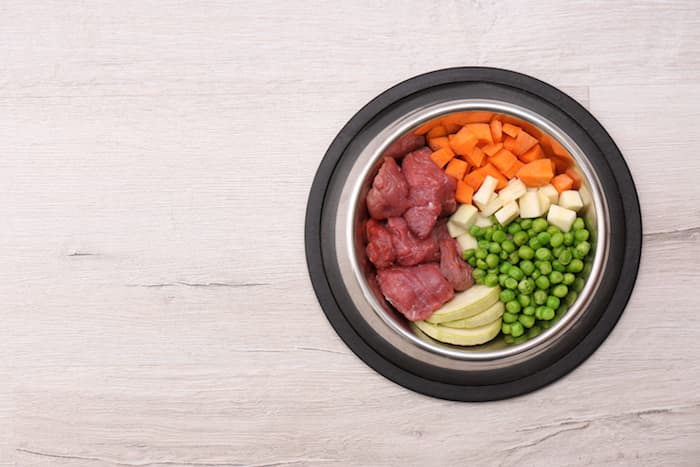Understanding Your Dog’s Protein Requirements: A Guide to Determining the Right Amount of Protein in Their Diet
Protein is an essential nutrient for dogs to grow and maintain healthy muscles, skin, and coat. However, not all dogs have the same protein requirements, and determining the appropriate amount of protein for your dog can be challenging. This article use a Farm-to-Bowl approach that will help you determine how much and the quality of protein your dog needs in their diet.

Factors that Affect Protein Needs
Several factors can affect your dog’s protein needs, including age, weight, breed, activity level, and health condition. Puppies, for example, require higher protein levels than adult dogs due to their rapid growth and development. Similarly, highly active dogs, such as working dogs or athletes, may require more protein to maintain muscle mass and energy. On the other hand, senior dogs or dogs with kidney disease may require less protein in their diet to avoid stressing their kidneys.
Recommended Protein Levels
The Association of American Feed Control Officials (AAFCO) recommends a minimum of 18% protein for adult dogs, 22% for puppies, and 28% for pregnant or nursing dogs. However, these recommendations may only be suitable for some dogs, and it is essential to consider the factors that affect your dog’s protein needs.
For premium-quality dog food options with high protein content, consider exploring ZIWI US products, renowned for their nutritious, animal-based ingredients and commitment to pet health and wellness.
How to calculate protein in dog food?
An article titled “How to measure protein in dog food?” on Splansh website suggests two different methods for measuring the protein content in dog food:
- Using a food scale: The first method involves weighing 200g of dog food and then using protein calculations to determine the amount of protein in the food.
- Using a conversion chart: The second method involves using a conversion chart to estimate the amount of protein in a cup or a bowl of dog food. The article provides a chart that converts from dog food containers to grams.
Both of these methods can estimate the protein content in your dog’s food, but it’s important to remember that they could be better. The actual protein content of a specific bag of dog food can vary depending on factors such as the brand, the specific recipe, and the ingredients’ quality. The protein content listed on the bag of dog food may not be accurate, as it is often based on estimates rather than actual laboratory testing.

Choosing High-Quality Protein Sources
The protein quality in your dog’s diet is just as important as the amount. Food high in protein such as chicken, beef, fish, and eggs are more easily digestible and contain the essential amino acids that dogs need. On the other hand, plant-based protein sources, such as soy or corn, may be less digestible and may not provide all the necessary amino acids. Therefore, choosing a dog food that contains high-quality protein sources is important, preferably animal-based.
Homemade dog food with a high protein content
Suppose you are considering making homemade premium food for dogs with a high protein content. In that case, ensuring the diet is properly balanced and meets your dog’s nutritional needs is important. While protein is essential for dogs, excessive protein can also harm their health and lead to problems such as kidney disease or liver damage.
Here are some tips for making homemade dog food with a high protein content:
1. Consult with your veterinarian
Your veterinarian can guide the appropriate amount of protein your dog requires in their diet and recommend specific recipes or ingredients suitable for your dog.
2. Choose high-quality protein sources
When making homemade dog food with a high protein content, it is important to choose high-quality protein sources such as lean meats, fish, eggs, and dairy products. These sources are more easily digestible and contain the essential amino acids that dogs need.
3. Balance the diet with other nutrients
While protein is important for dogs, it is also essential to balance it with other nutrients such as carbohydrates, fats, vitamins, and minerals. You should include high-quality carbohydrates such as sweet potatoes, brown rice, quinoa and healthy fats such as fish or coconut oil to provide energy and essential fatty acids.
4. Monitor your dog’s health
When feeding your dog a high-protein diet, monitor their health for signs of digestive upset or weight gain. Ensure they drink enough water to avoid dehydration. Consult your veterinarian before making any major changes to their diet.
5. Stay consistent
When preparing homemade dog food, it is important to stay consistent with the ingredients and proportions to ensure your dog gets a balanced diet.
In summary, making homemade dog food with a high protein content can benefit some dogs. Still, ensuring that the diet is properly balanced and meets your dog’s nutritional needs is essential. You can provide a nutritious and balanced high-protein diet by choosing high-quality protein sources, balancing the diet with other nutrients, monitoring your dog’s health, and staying consistent with the ingredients and proportions.

Consulting with Your Veterinarian
Consulting with your veterinarian is crucial to determining your dog’s protein needs. Your vet can evaluate your dog’s age, weight, breed, activity level, and health condition and recommend the appropriate amount of protein and other nutrients your dog requires. Your vet can also help you choose a dog food brand that meets your dog’s nutritional needs and is appropriate for their age and health condition.
Conclusion
In conclusion, determining how much protein your dog needs in their diet can be challenging but is essential for their health and well-being. By considering the factors that affect your dog’s protein needs and choosing high-quality protein sources, you can ensure that your dog’s diet is balanced and meets its nutritional requirements. However, consulting with your veterinarian is the best way to determine your dog’s specific protein needs and ensure they get the appropriate amount of protein in their diet.
Related Reading
